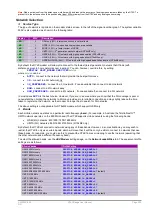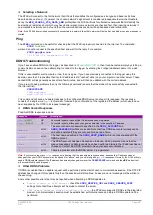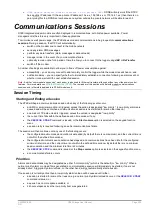
UM-0085-B09
DT80 Range User Manual
Page 207
RG
Subnet Mask
The
DT80
's Ethernet IP address actually consists of two parts:
•
The
network number
, which identifies the network to which the
DT80
and its neighbours are connected.
•
The
node number
, which uniquely identifies this
DT80
. No two devices on the network may have the same
node number. Also known as a
host number
.
The
subnet mask
is a property of the network to which the
DT80
is connected and specifies which part of the IP address
is the network number and which is the node number.
For example, the subnet mask
255.255.255.0
specifies that the first three parts of the IP address are the network
number, and the last is the node number within the network. So in this case the IP address
192.168.2.101
would
represent node
101
on the "
192.168.2
" network.
As with the IP address, the subnet mask can be set manually using a profile setting, or it can be assigned automatically
by a DHCP server.
Note:
The subnet mask is not applicable to point-to-point connections; it is only relevant for Ethernet.
Gateway
The
DT80
can communicate directly with any of the nodes connected to its local Ethernet network, or to the computer at
the other end of a point-to-point link. In some cases this is all the connectivity that is required.
If, however, the
DT80
needs to be accessed from farther afield then it needs to know how to communicate with
computers on different networks. This is done by assigning one of the computers on the
DT80
's local network to be a
gateway
. The IP address of the gateway is then entered into the
DT80
.
Now, any time the
DT80
wants to talk to a computer on a "foreign" network it will simply passes the data to the
designated gateway and let it sort it out. The gateway may then pass the data on to other gateways, until eventually the
data finds its way to its destination. See also
.
As hinted above, if you only want to connect your
DT80
to one computer, or to a few computers which are all on the
same local network, then it is not necessary to specify a gateway. As with the IP address, the gateway IP address can be
set manually using a profile setting, or it can be assigned automatically by a DHCP server.
For a point-to-point serial or
DtUsb
connection, the gateway is not relevant because in these cases the network beyond
the computer at the other end of the link is not visible to the
DT80
.
For a mobile network connection using the integrated modem, the gateway will be set up automatically during the
connection process.
DNS Server
Most networks include a
Domain Name System (DNS)
server. This is responsible for translating names such as
ftp.datataker.com
into numeric IP addresses. If the
DT80
is configured with a valid DNS server address then the current
job will be able to access FTP servers by name rather than having to use a raw IP address.
As with the IP address, the DNS server IP address can be set manually using a profile setting, or it can be assigned
automatically by a DHCP server. Often two DNS server addresses are specified – a primary one and a backup.
For a point-to-point serial or
DtUsb
connection, the DNS server is not relevant because in these cases the network
beyond the computer at the other end of the link is not visible to the
DT80
. For a mobile network connection using the
integrated modem, the DNS servers will be set up automatically during the connection process.
Integrated Modem
Only applicable to DT8xM models
The
DT80
'M' models (DT80LM/82EM/85LM/85GLM) include an integrated wireless (cellular) modem. This allows you to:
•
connect the logger to the internet wherever there is mobile coverage
•
configure and monitor the logger over the internet using
dEX
(if permitted by your mobile plan).
•
wirelessly unload data to an FTP server or your email inbox
•
send SMS alarm messages to a mobile handset
•
send email alarm messages to your computer or smartphone
The DT82EM3, DT80LM3 and DT85LM3 variants support 2G and 3G networks (
GSM
/
GPRS
/
EDGE
/
WCDMA
), while
the corresponding DT8xM2 models support 2G networks only (
GSM
/
GPRS
/
EDGE
).
















































